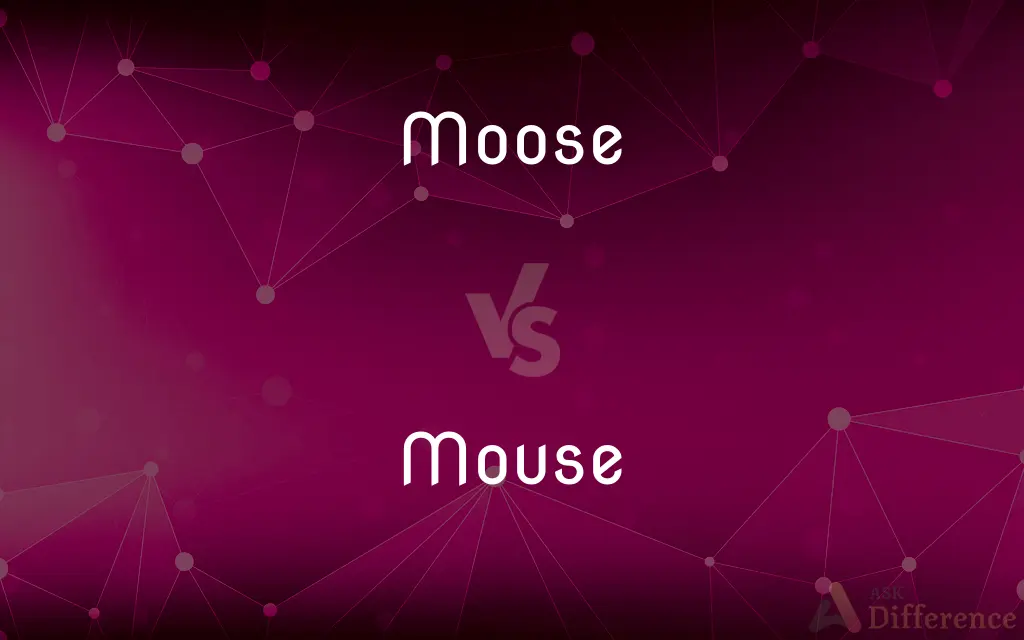Moose vs. Mouse — What's the Difference?
Edited by Tayyaba Rehman — By Urooj Arif — Updated on March 29, 2024
A moose is a large, herbivorous mammal known for its massive antlers, found in northern forests, whereas a mouse is a small, omnivorous rodent with a pointed snout and a long, thin tail.

Difference Between Moose and Mouse
Table of Contents
ADVERTISEMENT
Key Differences
Moose are among the largest mammals in the deer family, residing in the cold climates of the Northern Hemisphere. They are known for their towering size, long legs, and distinctive antlers that can span over six feet across. In contrast, mice are significantly smaller, widespread across various environments globally, and recognized by their compact bodies, pointed snouts, and long, thin tails. These size and habitat differences highlight the diverse adaptability and ecological roles of each species.
While moose are solitary creatures that prefer the solitude of dense boreal forests, wetlands, and mountainous areas, mice are highly adaptable, often living in close proximity to human settlements as well as in wild areas. This adaptability makes mice one of the most ubiquitous mammals on earth, whereas the moose's requirements for large, undisturbed tracts of forest limit their range to more remote areas.
The diet of a moose is strictly herbivorous, consisting mainly of shoots, leaves, and aquatic plants, reflecting their role as large herbivores in their ecosystems. Mice, on the other hand, are omnivores, feeding on a wide variety of foods from seeds and grains to insects, demonstrating their versatility and ability to survive in diverse conditions.
Moose play a significant role in their ecosystems as large herbivores, affecting the structure and composition of their habitats. They are key in shaping the vegetative landscape, which in turn influences the habitats of other animals. Mice, while much smaller, also play a crucial role, particularly in seed dispersal and as a food source for a wide range of predators, showcasing the importance of each species in maintaining ecological balance.
The reproductive strategies of these animals also differ markedly. Moose have a seasonal breeding season, with males competing for females through displays of strength and antler size. Mice, however, reproduce rapidly and throughout the year, with a single pair capable of producing a large number of offspring, which has implications for their population dynamics and interactions with their environments.
ADVERTISEMENT
Comparison Chart
Size
Large, with height up to 6.5 feet
Small, body length 3-4 inches
Habitat
Northern forests, wetlands
Diverse, including urban areas
Diet
Herbivorous, prefers shoots and aquatic plants
Omnivorous, includes seeds and insects
Social Behavior
Solitary
Social in groups, especially in nesting
Reproduction
Seasonal breeder, fewer offspring
Rapid breeder, numerous offspring
Role in Ecosystem
Influences vegetation and landscape
Seed dispersal, prey for predators
Antlers/Tail
Large antlers in males
Long, thin tail
Adaptability
Adapted to cold, undisturbed habitats
Highly adaptable to various environments
Compare with Definitions
Moose
Plays a crucial role in their ecosystem.
By feeding on certain plants, moose help shape the landscape of their habitats.
Mouse
Adaptable to various environments, including urban areas.
Mice have adapted to live near human settlements, finding food and shelter.
Moose
Predominantly found in cold climates of the Northern Hemisphere.
Moose are commonly seen in the cold, dense forests of Canada.
Mouse
Serves as a vital part of the food chain.
The presence of mice provides essential food for various predators like owls and foxes.
Moose
A large, northern forest-dwelling mammal with distinctive antlers.
The moose waded through the lake, foraging for aquatic plants.
Mouse
Can be found in nearly all types of habitats worldwide.
From deserts to rainforests, mice have colonized diverse ecosystems.
Moose
Herbivorous and prefers solitary living.
A solitary moose was spotted grazing in the forest clearing at dawn.
Mouse
A small, omnivorous rodent with a pointed snout.
The mouse scurried across the kitchen floor, searching for crumbs.
Moose
Known for their massive antlers, unique to males.
The male moose's antlers spread impressively wide as it stood in the meadow.
Mouse
Rapid breeder with a potential for large offspring numbers.
A single mouse can give birth to multiple litters in a year.
Moose
A large deer (Alces alces) of northern North American and Eurasian forests, having a broad pendulous muzzle, humped shoulders, and large, palmate antlers in the male.
Mouse
A mouse, plural mice, is a small rodent. Characteristically, mice are known to have a pointed snout, small rounded ears, a body-length scaly tail, and a high breeding rate.
Moose
The largest member of the deer family (Alces americanus, sometimes included in Alces alces), of which the male has very large, palmate antlers.
We saw a moose at the edge of the woods.
Mouse
A small rodent that typically has a pointed snout, relatively large ears and eyes, and a long tail.
Moose
Any of the extinct moose-like deer of the genera Cervalces and Libralces.
Mouse
A small handheld device which is moved across a mat or flat surface to move the cursor on a computer screen
The right mouse button
Copy the file with a click of the mouse
Moose
An ugly person.
Mouse
A lump or bruise on or near the eye
She touched the mouse under her eye
Moose
An Asian girl taken as a lover.
Mouse
(of a cat or owl) hunt for or catch mice
Female cats are usually much better at mousing than males
Moose
A member of the Progressive Party; a Bull Moose.
Mouse
Use a mouse to move or position a cursor on a computer screen
Simply mouse over any item on the list
Moose
A member of the fraternal organization named Loyal Order of Moose.
Mouse
Any of numerous small rodents of the families Muridae and Cricetidae, such as the house mouse, characteristically having a pointed snout, small rounded ears, and a long naked or almost hairless tail.
Moose
Large northern deer with enormous flattened antlers in the male; called elk in Europe and moose in North America
Mouse
Any of various similar or related animals, such as the jumping mouse, the vole, or the jerboa.
Mouse
A cowardly or timid person.
Mouse
(Informal) A discolored swelling under the eye caused by a blow; a black eye.
Mouse
Pl. mice or mous·es (mousĭz) Computers A handheld, button-activated input device that when rolled along a flat surface directs an indicator to move correspondingly about a computer screen, allowing the operator to move the indicator freely, as to select operations or manipulate text or graphics.
Mouse
To hunt mice.
Mouse
To search furtively for something; prowl.
Mouse
Any small rodent of the genus Mus.
Mouse
(informal) A member of the many small rodent and marsupial species resembling such a rodent.
Mouse
A quiet or shy person.
Mouse
(computing) (plural mice or, rarely, mouses) An input device that is moved over a pad or other flat surface to produce a corresponding movement of a pointer on a graphical display.
Mouse
(computing) The cursor.
Mouse
(boxing) A facial hematoma or black eye.
Mouse
(nautical) A turn or lashing of spun yarn or small stuff, or a metallic clasp or fastening, uniting the point and shank of a hook to prevent its unhooking or straightening out.
Mouse
(obsolete) A familiar term of endearment.
Mouse
A match used in firing guns or blasting.
Mouse
(set theory) A small model of (a fragment of) Zermelo-Fraenkel set theory with desirable properties (depending on the context).
Mouse
(historical) A small cushion for a woman's hair.
Mouse
Part of a hind leg of beef, next to the round.
Mouse
(intransitive) To move cautiously or furtively, in the manner of a mouse (the rodent) (frequently used in the phrasal verb to mouse around).
Mouse
(intransitive) To hunt or catch mice (the rodents), usually of cats. 12
Mouse
To close the mouth of a hook by a careful binding of marline or wire.
Mouse
To navigate by means of a computer mouse.
Mouse
To tear, as a cat devours a mouse.
Mouse
Any one of numerous species of small rodents belonging to the genus Mus and various related genera of the family Muridæ. The common house mouse (Mus musculus) is found in nearly all countries. The American white-footed mouse, or deer mouse (Peromyscus leucopus, formerly Hesperomys leucopus) sometimes lives in houses. See Dormouse, Meadow mouse, under Meadow, and Harvest mouse, under Harvest.
Mouse
A knob made on a rope with spun yarn or parceling to prevent a running eye from slipping.
Mouse
A familiar term of endearment.
Mouse
A dark-colored swelling caused by a blow.
Mouse
A match used in firing guns or blasting.
Mouse
To watch for and catch mice.
Mouse
To watch for or pursue anything in a sly manner; to pry about, on the lookout for something.
Mouse
To tear, as a cat devours a mouse.
Mouse
Any of numerous small rodents typically resembling diminutive rats having pointed snouts and small ears on elongated bodies with slender usually hairless tails
Mouse
A hand-operated electronic device that controls the coordinates of a cursor on your computer screen as you move it around on a pad; on the bottom of the mouse is a ball that rolls on the surface of the pad;
A mouse takes much more room than a trackball
Mouse
To go stealthily or furtively;
..stead of sneaking around spying on the neighbor's house
Mouse
Manipulate the mouse of a computer
Common Curiosities
How do moose adapt to their cold environments?
Moose have thick fur and a layer of fat to insulate against the cold, and they forage for specific plants that sustain them through winter.
Can moose be found in urban areas?
Moose occasionally wander into urban areas, but they primarily inhabit remote forests and wetlands.
Are mice considered pests?
Mice can be considered pests when they inhabit human spaces, due to potential health risks and property damage.
What role do mice play in scientific research?
Mice are widely used in scientific research due to their genetic similarity to humans and rapid reproduction rates.
How do mice find their way into homes?
Mice can squeeze through small openings, attracted by the warmth and availability of food.
Why do mice have such a rapid reproduction rate?
Rapid reproduction compensates for high predation rates, ensuring the survival of the species.
How can you prevent mice infestations?
Preventing infestations involves sealing entry points, maintaining cleanliness, and removing food sources.
What are the main threats to moose populations?
Main threats include habitat loss, climate change, and predation by wolves and bears.
What distinguishes a moose from a deer?
Moose are the largest species in the deer family, distinguished by their massive antlers and size.
What is the significance of moose antlers?
Antlers are used in mating displays and conflicts between males for dominance and breeding rights.
How do mice communicate?
Mice communicate through a variety of sounds, some of which are ultrasonic, as well as through scent marking.
What is the lifespan of a moose in the wild?
Moose typically live 15 to 20 years in the wild, depending on environmental factors and predation.
How do moose contribute to biodiversity?
By affecting vegetation and serving as prey for large predators, moose contribute to the structural diversity of their habitats.
What diseases can mice transmit to humans?
Mice can transmit diseases such as hantavirus, salmonellosis, and leptospirosis through droppings and urine.
Are moose aggressive animals?
Moose generally avoid human contact but can become aggressive during mating season or if they feel threatened.
Share Your Discovery

Previous Comparison
Clean vs. Cleaned
Next Comparison
Metrics vs. VersificationAuthor Spotlight
Written by
Urooj ArifUrooj is a skilled content writer at Ask Difference, known for her exceptional ability to simplify complex topics into engaging and informative content. With a passion for research and a flair for clear, concise writing, she consistently delivers articles that resonate with our diverse audience.
Edited by
Tayyaba RehmanTayyaba Rehman is a distinguished writer, currently serving as a primary contributor to askdifference.com. As a researcher in semantics and etymology, Tayyaba's passion for the complexity of languages and their distinctions has found a perfect home on the platform. Tayyaba delves into the intricacies of language, distinguishing between commonly confused words and phrases, thereby providing clarity for readers worldwide.
















































